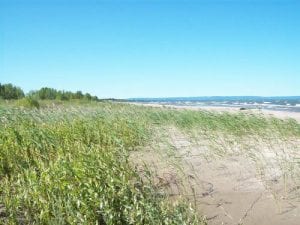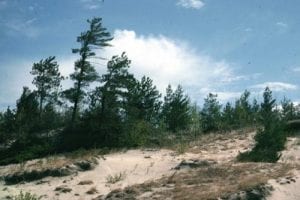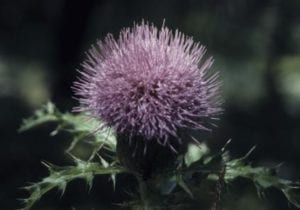Habitats and Ecosystems

Wasaga Beach shoreline
Mayflies, killdeer, ring-billed gulls, piping plovers, wormwood, sea rocket, and marram grass share Wasaga’s beach area with millions of visitors each summer. The 14-km beachfront not only provides recreation space for sunbathers and swimmers; it is also a diverse and active ecosystem.
The sand itself is constantly moving due to the effects of wind, waves, and currents from the Bay. These movements change the shape of the landscape, meeting habitat requirements of the wildlife living within. As the sand moves, native beach plants such as Marram Grass, which has an extensive root system to hold sand in place, help establish freshwater dunes, an ecosystem so rare, that it is considered globally imperilled.
Dunes, beach and shoreline all offer unique habitat components to the wildlife that make the beach their home. Threatened species, like the piping plover need the beach ecosystem for breeding. Although we can protect the species, it takes a community effort to protect the ecosystem they rely on for their survival. Respecting the boundaries of closed beach areas, taking time to walk around beach vegetation, and helping keep the beach clean are all ways in which you can be a part of the community effort. Learn more about piping plovers here.
Further inland from today’s existing shoreline, the habitat transitions into a pine-oak savannah. 300 years ago, the pine-oak savannah ecosystem was a common occurrence; however, today this system is considered rarer than the tropical rainforests. The pine-oak savannah is a transition zone between the tall grass prairies of the west and the Canadian Shield forests to the east. This ecosystem has been subjected to agricultural development, urbanization, and industrialization leaving less than one tenth of one percent of the original 13 million hectares that at one time reached from Wasaga Beach to Texas.

Oak-pine Savannah and parabolic dunes
A savannah is distinguished from woodland by the presence of a tree canopy that covers less than 30% of the sky. In a pine-oak savannah, scattered trees are surrounded by large open spaces filled with prairie wildflowers, grasses and shrubs, such as big and little bluestem, butterfly weed, New Jersey tea, and wild bergamot. All of these species have special adaptations for surviving in these shade-free living conditions. Some of these adaptations include waxy leaves that prevent rapid water loss, deep root systems or taproots, and seeds that germinate only after they are exposed to heat from fire.
In the past, pine-oak savannahs were maintained by naturally occurring ground fires roughly every 20 years. These fires would sweep through areas, preventing woodland from filling the open prairie spaces. Many of the species living in this ecosystem have deep taproots that allowed them to survive the fires and continue to flourish due to newly released nutrients.

Hill’s Thistle
One unique species that survives in this ecosystem is Hill’s Thistle, a endangered perennial measuring between 25 and 60 centimetres in height, grows in a dry, sandy soil that is prone to fire. It is a sun-loving plant that requires areas with low tree canopy cover. Flowering of this plant usually occurs in its third year of growth and its lightweight seeds are scattered by wind. Without the regular occurrence of fire, these seeds will not reach the soil to germinate because of accumulated leaves on the forest floor. This is one reason that Hill’s thistle is now considered a species at risk in Canada.

Prescribed burn
Over the past century, fire prevention has been the only resource management practice and consequently, leaf litter, brush, and shrub layers have accumulated in the savannah. Natural resource managers are now looking at the important role that fire must play in maintaining natural ecosystems. In many places, prescribed burning is practiced to re-open the forest canopy in savannah environments.
Wasaga Beach Provincial Park managers initiated a prescribed burn in the spring of 2004 as part of the Hill’s thistle recovery plan and also to open the rare pine-oak savannah. This prescribed burn covered an area of approximately 2 hectares and lasted a little longer than an hour. Park naturalists are conducting annual vegetation surveys to monitor Hill’s thistle and other prairie species following the burn to determine the effectiveness of such an endeavor.
